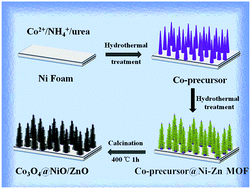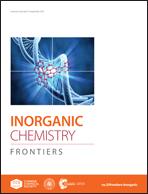Core–shell assembly of Co3O4@NiO-ZnO nanoarrays as battery-type electrodes for high-performance supercapatteries†
Abstract
Core–shell Co3O4@NiO-ZnO nanocomposite arrays are successfully fabricated by annealing metal–organic framework assisted precursors and are investigated as binder-free battery-type electrodes for supercapacitors with a remarkably enhanced performance. The Co3O4@NiO-ZnO electrode delivers ultrahigh areal capacitance/capacity (4678 mF cm−2/1965 C cm−2/302 C g−1 at a current density of 2 mA cm−2) and excellent cycling stability (83% retention over 10 000 cycles), due to multiple advantages offered by the intriguing core–shell structure, such as large surface area, fast electrolyte penetration, efficient charge transport, highly exposed active sites, and the synergistic effect between them. Moreover, an assembled supercapattery using Co3O4@NiO-ZnO arrays as a positive electrode and active carbon as a negative electrode yields a high energy density of 162 μW h cm−2 at a high power density of 1.676 mW cm−2 and a superior capacitance retention of 93% over 10 000 cycles. These excellent results indicate that this efficient strategy can be extended to prepare core–shell-type multi-metallic oxide arrays for high-performance supercapatteries.



 Please wait while we load your content...
Please wait while we load your content...